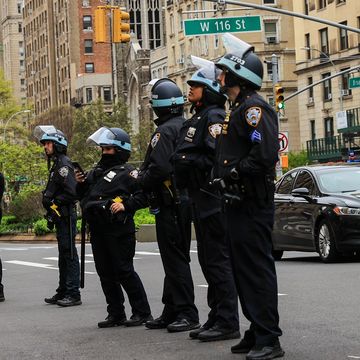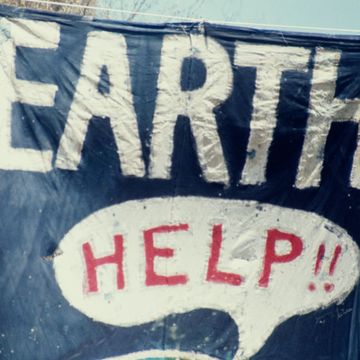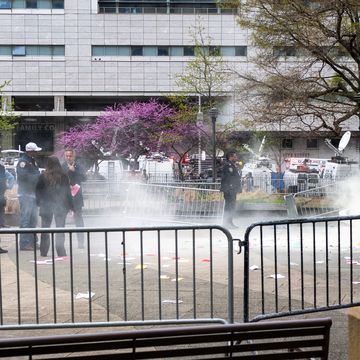Today's magnitude 7.5 earthquake near Mexico City was another spike in what feels more like a developing story than individual news events. In the past few days earthquakes in Nevada, Tokyo, Idaho, and Rutland, UK, have made headlines, and they're just the tip of the iceberg. We keep hearing doomsday scenarios from the dark corners of the Internet, bolstered by reports of animals fleeing Yellowstone Park and "Blood Moons."
To cut through our paranoia we went straight to the source, Jennifer Strauss from the University of California's Berkeley Seismological Lab, and asked if this was indeed some harbinger of doom, the growling of something apocalyptic on the horizon, or if we're just being overly sensitive to the earth's rumblings. Her synopsis? It's a mixed bag.
Generally speaking, we're hyper aware of them. We're super connected and earthquakes have been in the news a lot this past year, especially in California, but earthquakes happen all the time, everywhere, on a very regular basis.
Right now, just in the past day, we've had about 216 earthquakes of every magnitude worldwide. I would say that's pretty normal. If we only look at earthquakes above magnitude 2.5, in the last month there's been more than 1500. But magnitude 2.5 is really small, so not all of these are felt earthquakes. If you're looking at felt earthquakes, which are usually around magnitude 4.5, then in the past month there's been about 580.
I don't want to make predictions, but this is completely reasonable in terms of what is usually happening.
They come in cycles. If you're talking about California, we're past due for some earthquakes.
For example the Hayward fault, in Northern California has an occurrence interval roughly on a 140-year scale. The error bars on that are pretty big, so I'm not saying every 140 it happens. Could be 100 years, could be 180 years, but on average for the past seven earthquakes that have happened it's been every 140 years. So you think about the fact that the last earthquake that we had on the Hayward fault was in 1868, you do some math, 1868 plus 140 years is quite a few years ago.
We do hazard maps, and we can say, according to the last map, that the Hayward fault has, very roughly, a 20 percent chance of rupturing a magnitude 6.7 in the next 30 years.
What would that mean? A magnitude 6.7 would definitely be a felt earthquake. By comparison, the 1989 Loma Prieta earthquake was a magnitude 6.9, so roughly that scale of damage and injuries. We have the hope that it won't be as catastrophic, because we've done some hazard mitigation work. But in a shaking scenario it'll be very similar.
When you think about large earthquakes, when you think about the 2011 Tohoku earthquake, that was a 9.0, that's a massive earthquake. The Chilean earthquake was a 9.5, that's probably the biggest earthquake we've seen, magnitude-wise. Whereas destruction-wise 2004 Sumatra was actually very destructive, but that's a lot to do with the building stock there, and the tsunami that came afterwards.
Hollywood has sort of done us a disservice. When you have faults separating or faults sliding next to each other, you're not opening these massive crevices in the earth that cars are going to be swallowed in. This is not the sort of thing that actually happens.
The Cascadian Subduction Zone. In terms of length and possibility of creating the highest magnitude earthquake for the United States, the Cascadia Subduction Zone is probably it. The Cascadia runs from the southwest tip of Canada all the way down to Northern California. And that one has not ruptured in a wide scale event since the 1700s. Seven in the last 35 thousand years. It's been 314 years. It's locked and loaded.
So now we're at, "is it gonna happen now, or do we have another 200 years to wait?"
These ones are hard to do, just because of the way that you figure out historic earthquakes – we've only had seismometers in the ground since just prior to 1900. We didn't have any instruments to measure these sorts of things, so you do paleoseismology. You look at word of mouth, records, you do digs, and look at the sediment layers in a certain area across the fault.
This isn't the official word or anything. We don't generally think in terms of an earthquake ripping from the bottom of South America all the way up to Alaska. Because most of the faults are just not continuous. Could there be a whole field triggering of all these plates? It's an interesting thought experiment, but we don't generally think in those sorts of doomsday terms.
There are certain ideas floating around, and I am not saying which side of the fence I am on any of these ideas, but just for informational purposes, there are groups that are beginning to look at climate change and earthquakes. Not that climate change is gonna trigger more earthquakes, but are rising sea levels going to impact the average water table levels, which in turn impact liquefaction zones? Are we going to increase the likelihood of liquefaction in areas near known liquefaction zones, which would be hazardous in the effect of an earthquake?
There are also groups looking into whether hydrofracking is triggering earthquake events. You see an increase in earthquake activity in areas like Oklahoma that are generally not super earthquake prone. It doesn't mean that they're not naturally occurring earthquakes. Nobody has come to a conclusion about that. But there are people looking into the fact that these two things are happening at the same time, and is one thing triggering the rise in felt earthquakes in an area that doesn't have felt earthquakes?
The State of California is working on an earthquake early warning project that the Berkeley Seismic Lab, Cal Tech, University of Washington, and the USGS are intimately involved in, with the Office of Emergency Services in the State of California, and so we're trying to give people a little bit of a heads up before an earthquake happens so that they can take safety precautions.
The most important thing to do in an earthquake is to drop, cover, and hold on.













